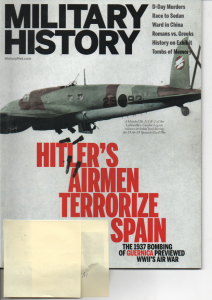Video from France 24 – Picasso’s Guernica: The world’s most famous anti-war painting
“Probably Picasso’s most famous work, Guernica is certainly the his most powerful political statement, painted as an immediate reaction to the Nazi’s devastating casual bombing practice on the Basque town of Guernica during Spanish Civil War…”
Guernica, 1937 by Pablo Picasso
The man, who our chapter of Veterans for Peace is name after, Clarence Kailin volunteered to fight as the Abraham Lincoln Brigade in defense of the elected Spanish government against a coup engineered by Generalissimo Francisco Franco with the backing of Germany’s Adolf Hitler and Italy’s Benito Mussolini.
Premature Antifascist – John Nichols
“The Spanish Civil War broke out in July, 1936, after a group of conservative military tried to overthrow the progressive government of the Popular Front, elected in February of the same year. Expecting an easy coup, the military rebels were surprised to encounter massive popular resistance, especially in the large urban centers. In a matter of days, the country was split in half, with one zone controlled by the government (known as Republicans, Loyalists, or Reds), and the other by the rebels (also referred to as Nationalists, Fascists, or Whites). Three years of bloody fighting followed. General Franco quickly emerged as the Nationalist commander in chief. The main leaders on the Republican side were President Azaña and Prime Ministers Largo Caballero and Negrín. The war ended with a Nationalist victory on April 1, 1939; Franco would rule Spain as a ruthless dictator until his death in 1975.
The war quickly became internationalized. Global public opinion rallied around one of the two factions, seeing the war as either a struggle of democracy against fascism or, conversely, of Christian civilization against Communism. Fearful of escalation, several Western governments signed a Non-Intervention Pact. It was a dead letter from the outset. Franco immediately requested and received extensive military support from Nazi Germany and fascist Italy. The Republic was in turn supported by the Soviet Union and, to a smaller extent, by Mexico. The other Western powers refused to stand by the embattled Republic, not even allowing it to buy arms on the international market. Nevertheless, thousands of concerned citizens from some fifty nations, ignoring their own governments’ purported neutrality, rallied to the Republic’s support. Almost forty thousand men and women, including 2,800 Americans, traveled to Spain to help fight fascism. Most of them joined the International Brigades, organized in 1936 by the Communist International. The U.S. volunteers in Spain formed several battalions and served in various units (medical, transportation) and came to be known collectively as the Abraham Lincoln Brigade.”
The Abraham Lincoln Brigade and the Spanish Civil War

Spanish Civil War: the Spanish town of Guernica, after the bombing by German and Italian aircraft, 1937. (Photo by: Universal History Archive/UIG via Getty Images)




this is interesting that the artwork is not only about art but also contain meaning in politics too